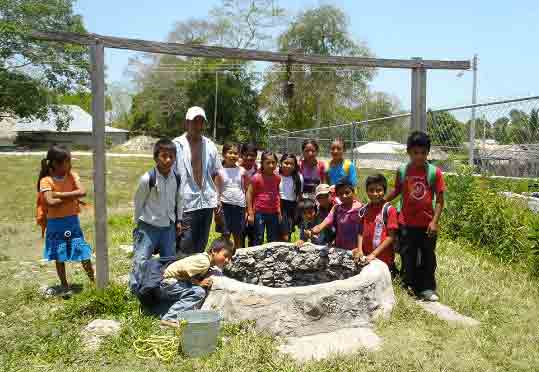In a small village deep in the jungles of the Yucatan Peninsula — a day’s drive from any source of clean, drinkable water — researchers from MIT are testing a system that purifies water with the help of the sun.
The relatively inexpensive system consists of several modest photovoltaic panels, a large tank to hold purified water, and a telephone booth-sized shed that houses the heart of the system: pumps, filters and membranes, and computers that enable the system to run itself.
The solar panels, programmed to maximize the capture of sunlight, power the system’s pumps to push brown, brackish well water through semiporous membranes — a process known as reverse osmosis. The membranes filter clean, drinkable water into a large tank, leaving behind salts and other heavy minerals. Even on a cloudy day, the solar-powered setup can produce about 1,000 liters of drinking water — enough to supply the village’s 450 residents.
The team, led by Steven Dubowsky, a professor of mechanical engineering and of aeronautics and astronautics, has operated the system for the past four months — a field test that, if successful, may be replicated in other parts of the world where fresh drinking water is a scarce and costly resource. The work is being done with the support of the Kellogg Foundation and the Fondo Para La Paz, a Mexican organization.
“There may be 25 million indigenous people in Mexico alone,” Dubowsky says. “This is not a small problem. The potential for a system like this is huge.”
Like many small villages in the Yucatan, the community hosting the MIT team has limited and intermittent access to water. Twice a week, local authorities deliver brackish water from distant groundwater wells. This water is not drinkable; instead, villagers use it to clean floors or wash clothes. Residents can also use rainwater, collected in large cisterns or lagoons, although they must first boil the water to avoid bacterial contamination.
Drinkable water is purchased in 20-liter bottles, which are trucked to the village. But the village only has a few working vehicles, and the villagers — most of whom are subsistence farmers — are scarcely able to afford the price of roughly 20 pesos per bottle of trucked-in water.
By contrast, Dubowsky says the MIT water purifier, installed directly in the village, produces a 20-liter bottle of drinking water for less than one peso. While the system is largely autonomous, the team is now training community members to maintain it, periodically changing out filters and replacing additives in the water.
“The maintenance of the system is going to be in the hands of the community,” Dubowsky says . “The idea is to give people a real sense of self-worth and self-reliance.”
In the future, Dubowsky envisions providing water-purification systems to other areas in need, scaling the system to the size of the community. He adds that the system’s parts, all commercially available, are designed to be user-friendly, “so that someone with the capabilities of an automobile mechanic could assemble this.”
From their time working in the village, the researchers have fine-tuned the system to perform better in field conditions. But they also came across unforeseen challenges, such as the limited water that was available to purify: The village only receives a delivery of brackish well water twice a week, while the MIT system is designed to purify water continuously. (This problem is solved by adding a 5,000-liter storage tank for the delivered water.) In the meantime, Dubowsky says that the technology’s performance has so far proven promising.
“This project approach is somewhat unique in work for small communities in the developing world,” Dubowsky says. “It is based on bringing to people the best technology to meet their needs. The challenge is to provide the training so they can operate and maintain the system.”

